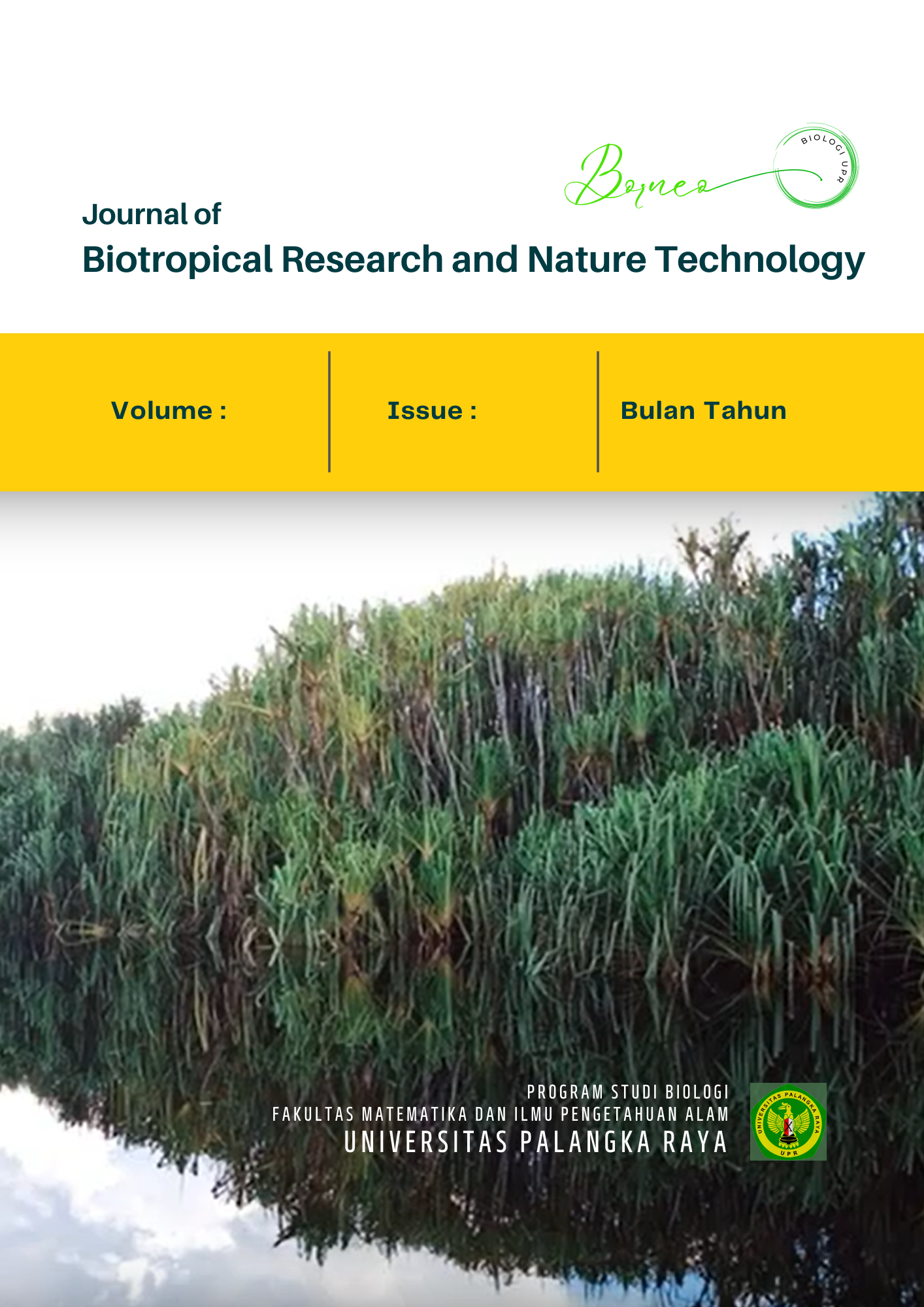Penambahan Pelet Trichoderma harzianum dalam Produksi Pupuk Organik Cair (POC) Limbah Tempe untuk Pertumbuhan Brassica juncea L.
DOI:
https://doi.org/10.52850/borneo.v3i1.13495Abstract
Tempeh waste is obtained from the tempeh processing cycle in the form of liquid waste. This waste contains protein, fat, carbohydrates, and water. The nutrient content contained in the waste can be utilized by microorganisms for making POC. Effective Microorganisms (EM4) is one of the strong activators used for making POC. Trichoderma harzianum is known as a decomposer that can improve compost quality and soil structure. This study aims to determine whether the POC produced affects the growth of Brassica juncea L. The experiment used a completely randomized design (CRD) with 4 treatments, namely P0 (control), P1 (60 ml/L), P2 (120 ml/L) and P3 (180 ml/L). with a total of 24 experimental units. Analysis of NPK and C-Organic nutrient content showed Nitrogen = 0.20%, P = 0.060%, K = 0.24%, Organic C = 1.43%. P3 dose (180 ml/L) is the best dose in mustard green growth which includes observations of plant height, number of leaflets, leaf width, leaf area, mustard wet weight and mustard dry weight.
Downloads
References
P. A. Hasan, A. P. Sari, A. K. S. Putera, dan M. Muliana, “Efektivitas Biofertilizer Limbah Cair Industri Tempe Terhadap Pertumbuhan Tanaman Bayam (Amanrathus Tricolor L.),” SAINTIFIK, vol. 9, no. 2, hlm. 265–271, Jul 2023, doi: 10.31605/saintifik.v9i2.424.
Novaty Eny Dungga, Rusnadi Padjung, dan Muh. Farid Bdr, “Peningkatan Pertumbuhan dan Produksi Bawang Merah Asal Biji (Allium ascalonicum L.) Melalui Pemberian Kompos Tithonia diversifolia dan Pupuk Organik Cair: Enhance the Growth and Production of Shallots from Seed (Allium ascalonicum L.) with Providing Tithonia diversivolia Compost Compound and Liquid Organic Fertilizer,” Perbal J. Pertan. Berkelanjutan, vol. 12, no. 2, hlm. 262–275, Jul 2024, doi: 10.30605/perbal.v12i2.4014.
D. Sari dan A. Rahmawati, “Pengelolaan Limbah Cair Tempe Air Rebusan dan Air Rendaman Kedelai,” J. Ilm. Kesehat. Media Husada, vol. 9, no. 1, hlm. 47–54, Apr 2020, doi: 10.33475/jikmh.v9i1.210.
S. Teddu, Ridwan, dan A. Ahmad, “Pemberdayaan Perempuan Dalam Mewujudkan Ketahanan Pangan Rumah Tangga Melalui Kelompok Wanita Tani di Kecamatan Mamuju Kabupaten Mamuju,” Tarjih Agribus. Dev. J., vol. 3, no. 02, hlm. 39–51, Jan 2024, doi: 10.47030/tadj.v3i02.710.
A. T. Perdana dan D. Widiawati, “Pemberdayaan Masyarakat dalam Pengolahan Limbah Cair Produksi Tempe di Kampung Tempe Kota Tangerang,” J. Pemberdaya. Masy. Univ. Al Azhar Indones., vol. 4, no. 1, hlm. 9, Des 2021, doi: 10.36722/jpm.v4i1.935.
B. Sugiharto dan N. K. Mu’alimah, “Pemanfaatan Mol Nasi Basi Sebagai Bioaktivator Pengomposan Sampah Daun Kering Dan Sampah Sayur,” Agroscience Agsci, vol. 13, no. 2, hlm. 161, Des 2023, doi: 10.35194/agsci.v13i2.3612.
M. Abror dan R. P. Harjo, “Efektifitas pupuk organik cair limbah ikan dan Trichoderma sp terhadap pertumbuhan dan hasil tanaman kailan (Brassica oleraceae sp) pada sistem hidroponik substrat,” J. AGROSAINS Dan Teknol., vol. 3, no. 1, hlm. 1, Jul 2018, doi: 10.24853/jat.3.1.1-12.
S. Rizal dan T. D. Susanti, “Peranan Jamur Trichoderma sp yang Diberikan terhadap Pertumbuhan Tanaman Kedelai (Glycine max L.),” Sainmatika J. Ilm. Mat. Dan Ilmu Pengetah. Alam, vol. 15, no. 1, hlm. 23, Jun 2018, doi: 10.31851/sainmatika.v15i1.1759.
R. I. Syarifain, M. R. Rashaun, E. D. Anggrainy, dan T. Simarmata, “Formulasi pembawa rizobakteri penambat nitrogen dan pelarut fosfat, serta aplikasinya di pembibitan kelapa sawit yang diberi komposisi dan dosis amelioran yang berbeda,” Kultivasi, vol. 21, no. 2, Agu 2022, doi: 10.24198/kultivasi.v21i2.38053.
R. Syafri, - Chairil, dan D. Simamora, “Analisa Unsur Hara Makro Pupuk Organik Cair (Poc) Dari Limbah Industri Keripik Nenas Dan Nangka Desa Kualu Nenas Dengan Penambahan Urin Sapi Dan EM4,” Photon J. Sain Dan Kesehat., vol. 8, no. 01, hlm. 99–104, Okt 2017, doi: 10.37859/jp.v8i01.539.
I. Kandida, M. Tari, dan A. Fatiqin, “Effectiveness of the Combination of Green Betel Leaf Extract (Piper betle) and Mint Leaf (Mentha piperita) as Antibacterials against Streptococcus mutans,” Bioactivities, vol. 1, no. 1, hlm. 32–38, Jun 2023, doi: 10.47352/bioactivities.2963-654X.184.
Y. Sulastri, Zainuri, E. Basuki, Baiq Rien Handayani, D. N. A. Paramartha, dan I. M. D. Anggraini, “Pengaruh fermentasi terhadap sifat fisikokimia tepung porang,” SAINTEK LPPM Univ Mataram, vol. 3, no. 1, 2021, [Daring]. Tersedia pada: https://jurnal.lppm.unram.ac.id/index.php/prosidingsaintek/article/view/258.
M. Rahmiyah, N. U. Maesaroh, dan P. Laeshita, “Media Alternatif Perbanyakan Trichoderma sp. dari Berbagai Jenis Limbah Sebagai Agen Pengendali Hayati,” Agroland J. Ilmu-Ilmu Pertan., vol. 30, no. 3, hlm. 217–227, Des 2023, doi: 10.22487/agrolandnasional.v30i3.1756.
S. A. M. Alamri, M. Hashem, Y. S. Mostafa, N. A. Nafady, dan K. A. M. Abo-Elyousr, “Biological control of root rot in lettuce caused by Exserohilum rostratum and Fusarium oxysporum via induction of the defense mechanism,” Biol. Control, vol. 128, hlm. 76–84, Jan 2019, doi: 10.1016/j.biocontrol.2018.09.014.
P. Kumar, R. C. Dubey, dan D. K. Maheshwari, “Bacillus strains isolated from rhizosphere showed plant growth promoting and antagonistic activity against phytopathogens,” Microbiol. Res., vol. 167, no. 8, hlm. 493–499, Sep 2012, doi: 10.1016/j.micres.2012.05.002.
S. Ji, Z. Liu, B. Liu, Y. Wang, dan J. Wang, “The effect of Trichoderma biofertilizer on the quality of flowering Chinese cabbage and the soil environment,” Sci. Hortic., vol. 262, hlm. 109069, Feb 2020, doi: 10.1016/j.scienta.2019.109069.
R. Riska, N. Rahmaniar, W. F. Karma, F. Ikrawati, dan M. Kadir, “Bioefficacy of Trichoderma harzianum and Chitosan Oligo-saccharin as Seed Coating to Control Fusarium oxysporum Disease in Peanut,” PROPER J. Penelit. Pertan. Terap., vol. 1, no. 2, hlm. 61–67, Des 2023, doi: 10.61119/prp.v1i2.380.
A. He, J. Liu, X. Wang, Q. Zhang, W. Song, dan J. Chen, “Soil application of Trichoderma asperellum GDFS1009 granules promotes growth and resistance to Fusarium graminearum in maize,” J. Integr. Agric., vol. 18, no. 3, hlm. 599–606, Mar 2019, doi: 10.1016/S2095-3119(18)62089-1.
R. P. John, R. D. Tyagi, D. Prévost, S. K. Brar, S. Pouleur, dan R. Y. Surampalli, “Mycoparasitic Trichoderma viride as a biocontrol agent against Fusarium oxysporum f. sp. adzuki and Pythium arrhenomanes and as a growth promoter of soybean,” Crop Prot., vol. 29, no. 12, hlm. 1452–1459, Des 2010, doi: 10.1016/j.cropro.2010.08.004.
H. Marhama, E. Triharyanto, dan M. T. S. Budiastuti, “Analisis pertumbuhan dan hasil varietas bawang merah dengan pupuk hayati di luar musim tanam,” J. AGRO, vol. 10, no. 2, hlm. 320–333, Des 2023, doi: 10.15575/30313.
Downloads
Published
How to Cite
Issue
Section
License
Copyright (c) 2024 Ike Apriani, Nabela Arinda Putri, Awalul Fatiqin, Riri Novita Sunarti

This work is licensed under a Creative Commons Attribution-ShareAlike 4.0 International License.
- Authors retain copyright and acknowledge that the Journal of Multidisciplinary Applied Natural Science is the first publisher, licensed under a Creative Commons Attribution-Share Alike 4.0 (CC BY-SA).
- Authors are able to enter into separate, additional contractual arrangements for the non-exclusive distribution of the journal's published version of the work (e.g., post it to an institutional repository or publish it in a book), with an acknowledgment of its initial publication in this journal.
- Authors are permitted and encouraged to post their work online (e.g., in institutional repositories or on their website) prior to and during the submission process, as it can lead to productive exchanges and earlier and greater citation of published work.








